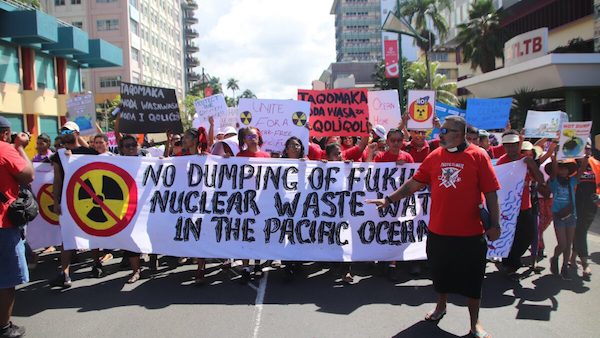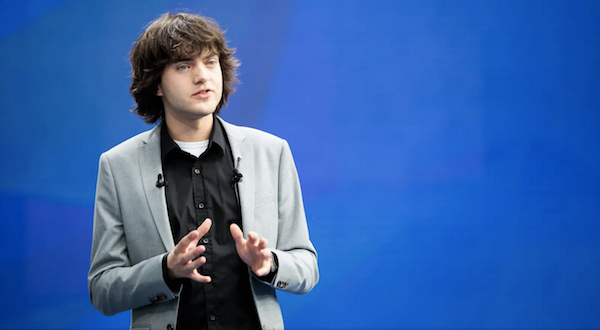
(quote)
In a decision steeped in controversy, Japan started releasing radioactive water from its Fukushima No. 1 nuclear power plant into the Pacific Ocean on Thursday.
In South Korea, protests and panic sales of sea salt have continued for months, while Hong Kong and Macau have issued their own bans on Japanese seafood from ten regions. China and Hong Kong made up 42 percent of the market for Japan’s seafood exports in 2022, Reuters reports.
TEPCO plans to release 31,200 tons of wastewater by the end of March 2024 before increasing the scale of the process. The IAEA launched a real-time website for public monitoring of the project.
Study: No Radiation Level Safe
The preponderance of scientific evidence shows that even very low doses of radiation pose a risk of cancer or other health problems and there is no threshold below which exposure can be viewed as harmless, a panel of prominent scientists concluded Wednesday. The finding by the National Academy of Sciences panel is viewed as critical because it is likely to significantly influence what radiation levels government agencies will allow at abandoned nuclear power plants, nuclear weapons production facilities and elsewhere.
“The scientific research base shows that there is no threshold of exposure below which low levels of ionized radiation can be demonstrated to be harmless or beneficial,” said Richard R. Monson, the panel chairman and a professor of epidemiology at Harvard’s School of Public Health. The committee gave support to the so-called “linear, no threshold” model that is currently the generally acceptable approach to radiation risk assessment. This approach assumes that the health risks from radiation exposure declines as the dose levels decline, but that each unit of radiation — no matter how small — still is assumed to cause cancer.
Buesseler consults for the Pacific Islands Forum, a coalition of nations including the Marshall Islands and Tahiti that are also apprehensive about Japan’s decision. He notes that many of these countries were subjected to high levels of radioactive fallout as a result of atmospheric nuclear tests during the Cold War. “There are islands they can’t return to…because of legacy contamination,” Buesseler says. Moreover, “they’re suffering in many ways from climate change and sea level rise more than the rest of the world,” he says. From their perspective, Japan’s release into the Pacific “is just one insult, environmentally, among others.”
…there’s a radioactive isotope that they cannot filter out: tritium. Tritium is an isotope of hydrogen, and hydrogen is part of the water itself (H20). So it is impossible to create a filter that could remove the tritium. Ken Buesseler, a senior scientist at the Woods Hole Oceanographic Institution, thinks it would have been better to keep the contaminated water on land, “where it’s much easier to monitor.” Options could have included mixing it into concrete to immobilize it.
South Korean shoppers hoard salt and seafood ahead of Japan’s release of treated radioactive water
…assurances have so far failed to alleviate concerns in neighboring nations like South Korea, where fishermen say their livelihoods are at risk and residents are stockpiling food items for fear of contamination, and China, which has banned food imports from some regions in Japan. Shoppers have even started hoarding other sea-based dietary staples like seaweed and anchovies, Reuters reported in June, citing Korean social media.
These anxieties were on display at Seoul’s largest fish market last week, where officials with radiation detectors tested fresh produce at various stalls in a bid to soothe worried shoppers, Reuters reported. South Korea has banned Japanese seafood imports from the Fukushima area since 2013, and said recently it planned to keep the order in place. But the ban hasn’t reassured Korean shoppers who fear the treated wastewater could impact marine life far beyond Japanese waters.
A Gallup Korea survey from June shows 78% of those polled said they were very or somewhat worried about contamination of seafood. When asked, some shoppers at fish markets told Korean media outlets and CNN affiliates that they might stop eating seafood once the wastewater is released.
Other countries are also taking action. On Friday, China announced it was banning imported food from 10 Japanese prefectures including Fukushima and stepping up its inspection and monitoring processes for food from other parts of the country. This measure aims to “prevent radioactive contaminated Japanese food from being exported to China,” the customs authority wrote in an online statement.
The public alarm is bad news for Japanese fishermen. Many Japanese fishermen had to suspend operations for years after the meltdown and barely managed to keep their businesses afloat. The wastewater release could be the final blow, some say.
South Korean fishermen who operate off the country’s southeast coast, close to Japan, could also feel the impact. “Now that more than 80% of the public are saying that they’re going to eat less seafood, that’s very worrying,” said Lee Gi-sam, a fisherman in the port city Tongyeong. “If the public avoids seafood, we’ll face a crisis of bankruptcy.”
‘Stop the dump’: Pacific communities protest Japan’s release of treated nuclear water
Protests were organized across the Pacific region after Japan started releasing treated water from the decommissioned Fukushima nuclear plant into the Pacific Ocean.
In Fiji, hundreds of residents took to the streets to denounce Japan’s dumping of treated water into the Pacific Ocean: “Japan’s actions in releasing radioactive waste water from the #Fukushima nuclear disaster into the #Pacific ocean is adding to intergenerational burdens for our region. The science is in, no matter what this violent and poisonous industry says. There is no safe dose of radiation.” Protests have been reported too, in Japan, South Korea, New Zealand, and the Philippines.
(unquote)
Image courtesy X (formerly Twitter) post by 350 Pacific






